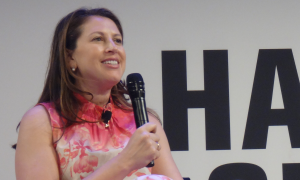NBA Takes Multiplatform Approach to Engaging Fans
League exec Melissa Rosenthal Brenner explains strategy, offers advice at Hashtag Sports conference
Story Highlights
Every social-media platform is a tool that sports teams and rights owners can use to engage with fans. The trick is understanding each platform’s strengths and speaking to its users in a tailored way. Speaking at the recent Hashtag Sports conference in New York City, Melissa Rosenthal Brenner, EVP, digital media, NBA, explained how online can complement linear broadcasts. During last month’s NBA Finals, the league took a cross-platform approach, using online platforms to tell deeper stories about its players.

NBA’s Melissa Rosenthal Brenner explains the league’s social-media strategy at last month’s Hashtag Sports event in New York City.
Because longer content is favored by the YouTube algorithm, that’s what the NBA featured. During the finals, 60% of its watch time was driven by YouTube, where it uploaded longer, more cinematic content. using such effects as slo-mo to create strong visuals and keeping the narrative tight.
The NBA’s Instagram strategy is evolving. Only a few months ago, Brenner believed that Instagram was a place for shorter content and that viewers had to be hooked in the first few seconds or they would keep scrolling. But IGTV changed that. Now the NBA populates videos to its main feed, and, after a minute, they go to IGTV. During the finals, of the 900 million video views on Instagram, 100 million were on IGTV.
Twitter is the place for real-time highlights and conversations. “NBA Twitter is a noun. It’s a living, breathing thing for us. It’s a vibrant community where our fans and our players, reporters from around the world, gather to talk about the best of hoops,” Brenner said. “Hopefully, you’re entertained, you’re informed, and it becomes a great companion to watching the game.”
When creating online video, she advised, let fans be in control. Sometimes, online viewers want a lean-back experience with everything chosen for them, but, more often, they enjoy interactivity. Live polling, a precursor to gambling, gets viewers involved, and interactive graphics let them call up information when they want it, perhaps finding out who’s on the court at the moment.
The NBA has been working with a company called Second Spectrum to create different viewing modes for different types of fans. That allows new fans, hardcore fans, kids, and gamblers to each enjoy an appropriate experience when tuning in, and the software will intuit which experience they should see.
Although that’s all attractive to fans, Brenner stressed that no online video would be successful without the contributions of the players. Citing LeBron James as an example, she noted, “He has over 100 million followers in social. That obviously rivals major brands. His content posting — whether it’s family or the schools that he founded and funds and supports or his insane off-season fitness regimen — if you haven’t seen it, you must, because it’s bananas. Just bringing it back from a player perspective, the players are really the center of all of the content.” Even on nights when James isn’t playing, he posts to social, she said, and that keeps fans engaged.
Being nimble and responding to online viewer demands has been a successful strategy for the NBA. Last season, the league realized that its League Pass offering was too limited for many viewers, offering only yearly or monthly passes, so it began offering access to single games. Then, based on fan feedback, it broke that down even further, offering quarter-by-quarter pricing, then 10-minute pricing (for just 99¢). Brenner said, “Social has forced us to look at how we handle transactions with our games in a much more granular way.”
The league has also jumped at the chance to try shoppable videos. Instagram recently began offering the feature. After the Toronto Raptors won the championship, the NBA and partner New Era offered a limited quantity of an exclusive hat and T-shirt, selling out in three hours and making more than they had from any product all year.
To know what works on each platform, content owners need to have a good relationship with the people at each one and take their lessons to heart, advised Michael Calderon, SVP, programming and digital media, Big Ten Network. To provide material that will get surfaced, learn about the algorithms each uses to surface content. Programming longer-form content builds watch time, and the YouTube algorithm will recommend those videos more often. It’s also important to know viewer practices. Around 70% of Twitter videos are watched with the sound off, so pay extra attention to the visual presentation. And never repurpose TV content on social platforms and expect it to work. Content needs to be tailored for each platform if it’s going to find an audience.
Said Calderon, “We’ve got a variety of ways that we’re generating revenue through video content on social.”
